Spiny freshwater crayfish
Scientific Name
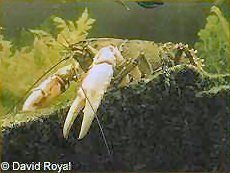 Murray Cray E. armatus |
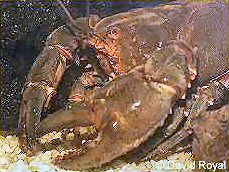 Gippsland Cray E. kershawi |
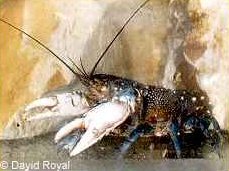 Yarra Cray E. yarraensis |
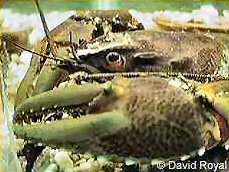 Glenelg Cray E. bispinosis |
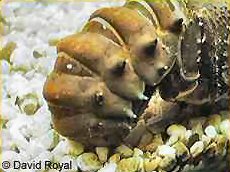 The tail of a Glenelg Cray E. bispinosis |
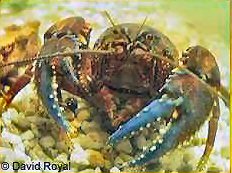 E. woiwuru |
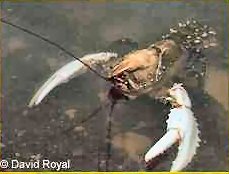 A Murray cray returning home after a photo shoot. |
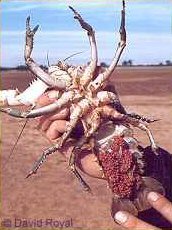 A cray in berry - these must be returned to the water unharmed |
Euastacus spp
Other Common Names
Spiny, cray, yabby (occasionally)
Murray cray E. armatus,
Yarra cray E. yarraensis,
Gippsland crayfish E. kershawi,
Glenelg Cray E. bispinosis,
New England crayfish E. suttoni,
Lamington Plateau crayfish E. sulcatus,
Sydney crayfish E. australasiensis
Note - this is not a complete list of all species in the Euastacus group.
The remaining information on this page refers specifically to the Murray cray E. armatus, although most of the information is applicable to all species in the group.
Size
A large species - Murray cray is the second largest freshwater crayfish in the world. To greater than 150 mm carapace length.
(The largest freshwater crayfish is the giant Tasmanian freshwater crayfish Astacopsis gouldi which grows to at least 400 mm overall and 3.6 kg and has been recorded at over 6 kg.)
Conservation Status
Insufficiently known
Habitat
Streams containing abundant instream debris and vegetation. Burrows underground during the warmer months.
Reproduction
Breeding occurs late winter to early spring. Females carry the eggs under the tail for up to five months. Spiny freshwater crayfish are slow growing and may take up to nine years to reach breeding maturity.
Diet
Fungi and bacteria in rotting debris, also an opportunistic carnivore, especially of carrion.
Angling
Freshwater crayfish are usually caught using hoop nets, which lie flat on the river bottom, with a suitable bait secured to the net. Can be abundant at times and are subject to size and bag limits, which should be closely observed.
Females "in berry" or carrying young are totally protected and should be quickly returned to the water.
On the table
Excellent eating, said by some to be the finest crustacean available anywhere, although the animal has a relatively small tail compared to other crayfish and thus has less edible meat. However, there is good meat inside the carapace adjacent to the leg entry points and this is well worth the effort to retrieve. The claws provide excellent meat as well, once the extremely hard shell has been cracked.
Eating spiny crays with your bare hands will soon inform you of why they are so named. <grin> The shell is covered with many needle sharp spines which leave their mark upon you.
The meat is sweet and does not need any elaborate sauce to assist the flavour. Crayfish are usually boiled in salted water for ten to twenty minutes, depending upon size. This is a popular past-time at various riverside beaches along the Murray during the cray season.
In the aquarium
Murray cray make spectacular aquarium specimens. Not usually available through the aquarium trade, capture from the wild is the only real option. Since minimum sizes apply, you will need a relatively large aquarium to successfully keep crayfish. Spiny crays are notorious escapologists and most would put Houdini to shame. Therefore you must ensure that you have a close fitting lid, preferably with a heavy object on top of it, to keep the very strong animal in the tank. One Native Fish Australia member returned home late one night to find his very large Murray cray several hundred metres down the road happily heading off for who knows where.
Relatively easy to keep, crays can be fed on small pieces of meat, earthworms, small pieces of carrot peel and the occasional piece of green vegetable matter, such a lettuce leaf, that has had its cell structure broken by freezing. A clean piece of heavy old wood, perhaps a bit of mallee root, will also be appreciated, and chewed on.
Crays will destroy anything in the tank made of plastic and will demolish air stones in quick order. A simple solution to this problem is to silicone a glass panel diagonally across one corner of the tank, leaving a 1-2 cm gap at the bottom and sufficient clearance at the top to allow for water flow, and to put any air stones etc behind it where the cray can't get at them. Whilst on the subject of crayfish's destructive habits, you should always handle them with extreme care as even quite modestly sized individuals are quite capable of removing the top of a finger with their pincers. <Ouch!>
On the web
Check our NFA member Dave Royal's great crayfish site - Crayfish World
For more details on the giant Tasmanian freshwater crayfish, see the Tasmanian Parks and Wildlife Service's page Giant Freshwater Lobster